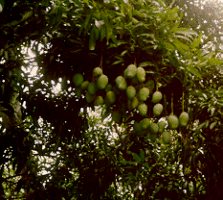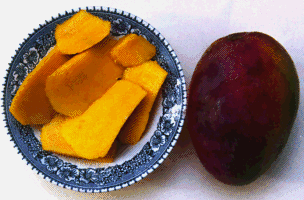

The mango (Mangifera indica) has been grown in India for more than 4000 years and is one of the oldest and most important fruits to be cultivated. It is believed to have originated in tropical to sub-tropical monsoon areas in the foothills of the Himalayas, between India and Burma.
During the reign of the Mughal Emporer, Akbar the Great (1500's), 200 varieties were developed around the city of Amroha. Prior to this they were introduced to Africa (1330's) and made their way to the Caribbean by the 1700's.
There are 41 species of Mangifera with 17 of them bearing edible
fruit.


In Jamaica, the varieties often have local names and altogether we find "black-greengage, black-sweetie", "stringy", beef, Bombay, East Indian, Haden, kidney, lady finger, Number 11, Parry, "pint o' water", Robin, St Julian ("Julie"), Tommy Atkins, turpentine.
The principal sugars in Haden have been identified as fructose (20.6%), glucose (5.3%) and sucrose (74.1%) and the total sugar content in a range of mangoes is roughly 5-12 g/100 g. Water makes up around 80 g / 100 g.
In ripe Alphonso mangoes, the organic acids, citric (61%), malic (24%), succinic (10%) and uronic (5%) were identified. The total acidity found for a range of mangoes was 0.3 - 0.5 g/ 100 g based on citric acid.
The yellow-orange characteristic colour of mangoes have been studied in detail and is
due to the presence of carotenoids.
A recent paper found that for the cultivar Keitt, all-trans-violaxanthin, all-trans-beta-carotene
and 9-cis-violaxanthin are the principal carotenoids present accounting for 38, 27
and 18% of the total. The earlier claims for beta-carotene being more prevalent than
violaxanthin were discounted as being due to the methods used in identification.
The red blush of the Haden mango is claimed to be due to the anthocyanidin, peonidin-3-galactoside.
VolatilesA 1985 study of Alphonso mangoes using GC/MS identified 152 volatile
compounds. The essences composed about 57 mg/ kg of fruit pulp and included (Z) and
(E)-ocimene and 2,5-dimethyl-4-hydroxy-3(2H)-furanone. |
"Tropical Fruit Processing", Edited by J. Jagtiani, H.T. Chan, Jr. and W.S.
Sakai Food Science and Technology, A series of monographs, 1988, Academic Press, Inc.,
1250 Sixth Avenue, San Diego, California, 92101.
"Food Flavourings", Edited by P.R. Ashurst, Blackie Academic & Professional,
an imprint of Chapman & Hall, Wester Cleddens Road, Bishopbriggs, Glascow, G64 2NZ,
UK. 2nd edit. 1995.
"HPLC and MS analysis of carotenoids from Mango", A.Z. Mercadante, D.B.
Rodriquez-Amaya and G Britton, J. Agric. Food Chem., 1997, 45, 12-123.
 Return to Chemistry, UWI-Mona, Home Page
Return to Chemistry, UWI-Mona, Home Page
Created May 1997. Last modified May 13th 1997, rjl